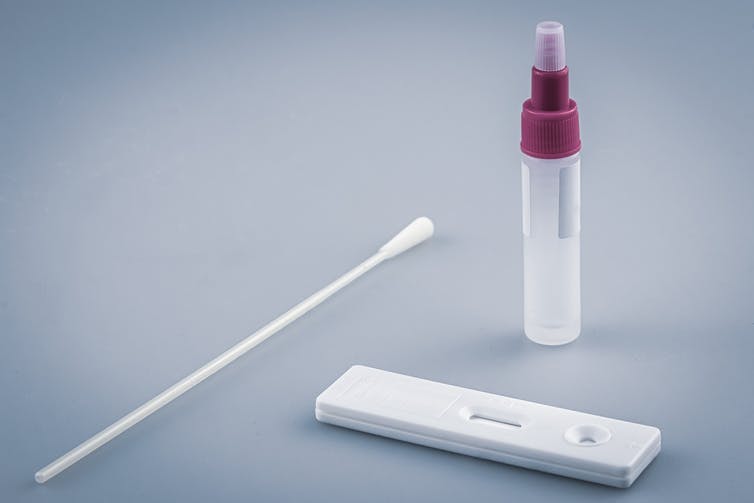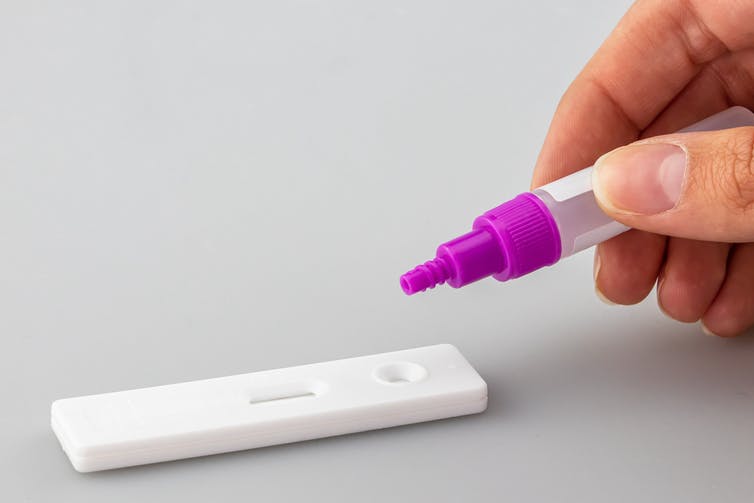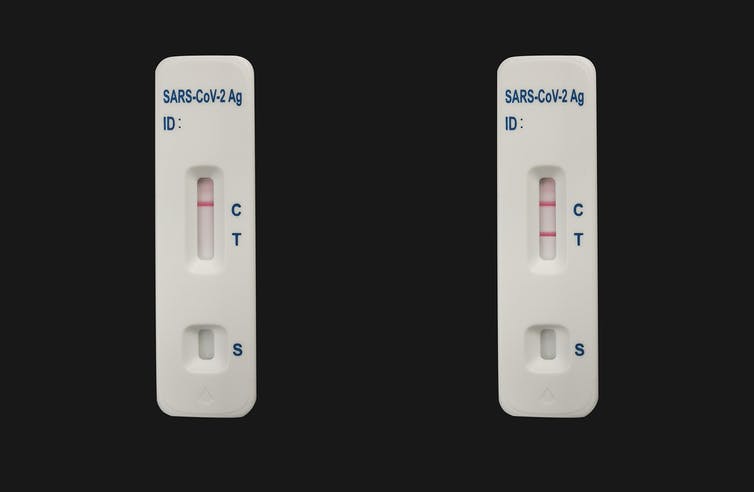Kristen haase, British Columbia University Y Don D. Sin, British Columbia University
This holiday season, we are all yearning for a little normalcy. For many, this means spending time with family and friends, and dropping the masks to sip eggnog. But even if you are fully immunized against COVID-19 (whether that is defined as two or three vaccines is currently up for debate), the infectivity of SARS-CoV-2, the virus responsible for COVID-19, means that you can still transmit the virus to other people.
Vaccination is the the best way to protect yourself against COVID-19. Even if they are infected, vaccinated people are less likely to have symptoms and more likely to have a mild course of infection. However, this means that you may not even know that you have SARS-CoV-2 (if the Delta variant or Omicron) and could unknowingly pass it on to someone else.
To protect the most vulnerable, including the immunosuppressed, the elderly and children who have not yet been vaccinated, the rapid antigen test (rapid test) is an additional measure that can help you have a more normal vacation, if used correctly . As healthcare professionals, we have been involved in rapid test research and clinical use during the pandemic. Here are some common questions and answers.
1. What is a rapid test?
Rapid antigen tests detect if your body is shedding the SARS-CoV-2 virus. Rapid tests are very easy to use, so easy that an eight-year-old can get to know the correct procedure well and teach adults how to do it.
For most tests, you insert a stick that resembles a cotton swab into each nostril for five seconds, roll it up, and then mix it with a liquid solution. Then, with a dropper, put the solution into a test kit (it looks like a pregnancy test). The result is ready in about 15 minutes.

A rapid test differs from the PCR (polymerase chain reaction) test, which measures amplified viral RNA. PCR tests are generally more invasive. The sample is collected with a nasopharyngeal swab that requires a sample from the nasal and pharyngeal passages near the back of the throat. It takes longer to get results (hours to days instead of minutes) and typically must be administered and processed by a healthcare professional. However, the PCR test is the only option if you have symptoms and require a diagnosis in the hospital or clinic.
2. What does a quick test really tell you?
A rapid antigen test tells you if you have the SARS-CoV-2 virus and are currently infectious, even when you are showing no symptoms (asymptomatic).

3. How long before an event do I have to do a quick test?
A rapid test result is considered valid for the day you receive the results. Therefore, it is most useful if you take the exam shortly before you plan to attend an event or be around other people.
But you have to be strategic about when to do it. For example, if you travel four hours to see Grandma on Christmas, you probably want to take the test before getting in the car, because if you show up at Grandma’s house, you take the test and find that it is positive, human nature It might make you both want to break the rules and have a quick visit.
With the infectivity of Delta variant and possibly Omicron, this is not a safe option.
If you have access to multiple tests and can test regularly, before you travel, before interacting with different groups of people on the same day, this is ideal.
4. When should I not use it?
Rapid tests should not be used when you have symptoms and require a clinical diagnosis. Why? Because if you have symptoms, you should self-isolate and / or take a PCR test, depending on your local guidelines and your personal vaccination status.
Your symptoms may not be related to COVID-19. They could also be due to the influenza virus, which could still be harmful to transmit to the immunosuppressed. If you are not feeling well, stay home and get a PCR test according to local guidelines. Period.
5. How much does it cost? Where can I find one?
In Canada, many small businesses have sprung up to provide rapid tests for travel with costs ranging from $ 75 to $ 130. But tests can also be purchased individually or by the box starting at $ 10 per test.
Publicly funded tests are more difficult to come by and availability varies by jurisdiction. The federal government gave quick tests to each province, but how they are shared varies greatly.

Emerging rapid test distribution centers have emerged in British Columbia communities with high rates of COVID-19 through the Fraser Health Authority. Saskatchewan has been distributing rapid tests through schools and business lobby groups, but has found that many people i don’t know how to use tests correctly. In Nova Scotia, infectious disease expert Dr. Lisa Barret has led a number of successful efforts to distribute rapid tests in the community, including Delivery of condoms and COVID tests to university students..
The bottom line
The best ways to protect yourself and your family from COVID-19 are to get vaccinated, wear a mask, keep your distance, and gather outside when possible. If you choose to meet in person, quick tests are one more tool in our toolbox for staying safe on vacation. Remember, rapid tests are not for people with symptoms, they are only for asymptomatic people.
Kristen haase, Assistant Professor, Nursing, British Columbia University Y Don D. Sin, Professor of Medicine, British Columbia University
This article is republished from The conversation under a Creative Commons license. Read the Original article.
Reference-ygknews.ca